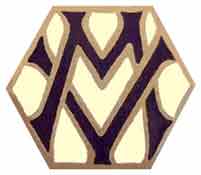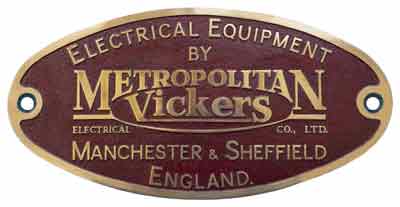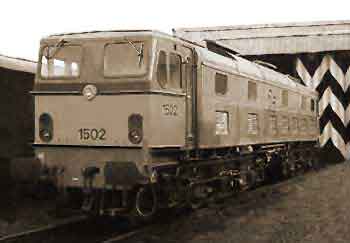

All locomotives, with the exception of the prototype, which was built at Doncaster, were built at the railway company's workshops at Gorton, Manchester, better known as 'Gorton Tank'. Metropolitan Vickers Electrical Company of Trafford Park, Stretford, Manchester, and of Sheffield, supplied all the electrical equipment for both classes of electrical locomotives, that is, the Bo-Bo EM1s (later Class 76) and the Co-Co EM2s (later Class 77). The operating voltage was 1,500 V dc.


It is understood that following the withdrawal of EM1 26 000 'Tommy' and the seven EM2s that they were stored at the Bury Shed until the Netherlands State Railway (NSR) expressed an interest in purchasing the EM2s. 'Tommy' was subsequently cut up at Crewe in Oct 1972.
In December 1973, the Class EM1 freight locomotives became Class 76 and the EM2 passenger locomotives became Class 77 although this was a paper class only, never carried by the locomotives.
Class EM1 (Bo-Bo)
Prototype locomotive numbered 6701 in 1940, then renumbered as 6000 in 1947 and then renumbered again as 26 000 in 1953.
All locomotives carried an 'E' prefix to their number until the new TOPS (Total Operations Processing Systems) numbering system applied from Dec 1973.
| BR No. & Name | When built | Works No. | 1971 No. | 1976 No. | Withdrawn | Comments |
|---|---|---|---|---|---|---|
| 26 000 Tommy (NoteThis LNER locomotive was the prototype of its class, which was completed in Aug 1940 and numbered 6701. Its first trials were on the east coast main line between Doncaster and Retford and after modifications it was added to the stock in Sep 1941. Further trials were then conducted on the Manchester, South Junction and Altrincham Railway where more modifications were made. On the 14 Oct 1941 the locomotive returned to Doncaster for storage until after the war. In 1947 it was brought out of storage and was renumbered 6000. After other modifications and cleaning it was again given trials on the east coast main line and then it was shipped to the Netherlands State Railway in Sep 1947. Some adjustments were made to it in the Netherlands and it returned to Britain in Feb 1952. On its return it was officially named Tommy, the nickname given to it by the Dutch in honour of the British liberation forces during the war.) |
9/1941 | 3/1970 | Prototype locomotive with boiler | |||
| 26 001 | 1950 | 1008 | 76 001 | 10/1980 | ||
| 26 002 | 1950 | 1009 | 76 002 | 6/1978 | ||
| 26 003 | 1950 | 1010 | 76 003 | 76 036 | 8/1980 | Fitted for Multiple Working (FfMW) (NoteThat is, two locomotives hauling one train.) |
| 26 004 | 1950 | 1011 | 76 004 | 6/1978 | ||
| 26 005 | 1950 | 1012 | 76 005 | 5/1970 | ||
| 26 006 | 1950 | 1013 | 76 006 | 7/1981 | FfMW | |
| 26 007 | 1950 | 1014 | 76 007 | 7/1981 | FfMW | |
| 26 008 | 1950 | 1015 | 76 008 | 6/1981 | FfMW | |
| 26 009 | 1950 | 1016 | 76 009 | 6/1981 | FfMW | |
| 26 010 | 1950 | 1017 | 76 010 | 7/1981 | FfMW | |
| 26 011 | 1950 | 1018 | 76 011 | 7/1981 | FfMW | |
| 26 012 | 1951 | 1019 | 76 012 | 7/1981 | FfMW | |
| 26 013 | 1951 | 1020 | 76 013 | 6/1981 | FfMW | |
| 26 014 | 1951 | 1021 | 76 014 | 7/1981 | FfMW | |
| 26 015 | 1951 | 1022 | 76 015 | 5/1981 | FfMW | |
| 26 016 | 1951 | 1023 | 76 016 | 7/1981 | FfMW | |
| 26 017 | 1951 | 1024 | 76 017 | 4/1971 | ||
| 26 018 | 1951 | 1025 | 76 018 | 76 035 | 7/1981 | FfMW |
| 26 019 | 1951 | 1026 | 76 019 | 10/1971 | Withdrawn after colliding with 031 | |
| 26 020 (NoteThe only EM1 to have suvived and now preserved in the National Railway Museum, York.) | 1951 | 1027 | 76 020 | 8/1977 | Boiler. | |
| 26 021 | 1951 | 1028 | 76 021 | 7/1981 | FfMW | |
| 26 022 | 1951 | 1029 | 76 022 | 7/1981 | FfMW | |
| 26 023 | 1951 | 1030 | 76 023 | 7/1981 | FfMW | |
| 26 024 | 1951 | 1031 | 76 024 | 7/1981 | FfMW | |
| 26 025 | 1951 | 1032 | 76 025 | 7/1981 | FfMW | |
| 26 026 | 1951 | 1033 | 76 026 | 7/1981 | FfMW | |
| 26 027 | 1951 | 1034 | 76 027 | 7/1981 | FfMW | |
| 26 028 | 1951 | 1035 | 76 028 | 7/1981 | FfMW | |
| 26 029 | 1951 | 1036 | 76 029 | 3/1981 | FfMW | |
| 26 030 | 1951 | 1037 | 76 030 | 3/1981 | FfMW | |
| 26 031 | 1951 | 1038 | 76 031 | 10/1971 | Withdrawn after colliding with 019 | |
| 26 032 | 1951 | 1039 | 76 032 | 7/1981 | FfMW | |
| 26 033 | 1951 | 1040 | 76 033 | 7/1981 | FfMW | |
| 26 034 | 1951 | 1041 | 76 034 | 7/1981 | FfMW | |
| 26 035 | 1951 | 1042 | 76 035 | 4/1970 | ||
| 26 036 | 1951 | 1043 | 76 036 | 76 031 (NotePaper number only. Never carried by locomotive.) then 76 003 | 8/1980 | FfMW |
| 26 037 | 1951 | 1044 | 76 037 | 7/1981 | FfMW | |
| 26 038 | 1951 | 1045 | 76 038 | 76 050 | 2/1977 | |
| 26 039 | 1951 | 1046 | 76 039 | 76 048 | 3/1981 | |
| 26 040 | 1952 | 1047 | 76 040 | 7/1981 | ||
| 26 041 | 1952 | 1048 | 76 041 | 5/1981 | ||
| 26 042 | 1952 | 1049 | 76 042 | 4/1970 | ||
| 26 043 | 1952 | 1050 | 76 043 | 6/1978 | ||
| 26 044 | 1952 | 1051 | 76 044 | 76 031 | 7/1981 | |
| 26 045 | 1952 | 1052 | 76 045 | 11/1971 | ||
| 26 046 Archimedes | 8/1952 | 1053 | 76 046 | 11/1980 | Boiler | |
| 26 047 Diomedes | 8/1952 | 1054 | 76 047 | 11/1980 | Boiler | |
| 26 048 Hector (NoteThe No. 1 cab of Hector is preserved in the Manchester Museum of Science and Industry.) |
9/1952 | 1055 | 76 048 | 76 039 | 7/1981 | FfMW. Boiler |
| 26 049 Jason | 9/1952 | 1056 | 76 049 | 11/1980 | Boiler | |
| 26 050 Stentor (NoteStentor was renumbered 76 050 in 1971 and then renumbered 76 038 in 1977. It was withdrawn from service in Jul 1981 and was stored at the Reddish Depot until Nov 1981. It was then moved to Guide Bridge where it remained until Apr 1983 when it was returned to the Reddish Depot. Shortly afterwards it was taken to Tinsley, Yorkshire, and from there it went to C F Booth Ltd at Rotherham where it was cut up for scrap.) |
11/1952 | 1057 | 76 050 | 76 038 | 7/1981 | Boiler |
| 26 051 Mentor | 12/1952 | 1058 | 76 051 | 7/1981 | Boiler | |
| 26 052 Nestor | 1/1953 | 1059 | 76 052 | 6/1978 | Boiler | |
| 26 053 Perseus | 3/1953 | 1060 | 76 053 | 11/1980 | Boiler | |
| 26 054 Pluto | 4/1953 | 1061 | 76 054 | 7/1981 | Boiler | |
| 26 055 Prometheus | 6/1953 | 1062 | 76 055 | 2/1977 | Boiler | |
| 26 056 Triton | 7/1953 | 1063 | 76 056 | 6/1978 | Boiler | |
| 26 057 Ulysses | 8/1953 | 1064 | 76 057 | 2/1977 | Boiler |
All nameplates were removed from Class EM1 locomotives between 1968 and 1970.
Class EM2 (Co-Co)
| BR No. & Name | When Built | Works No. | Paper No. only | Withdrawn by BR | Entered NSR Service | NSR No. |
|---|---|---|---|---|---|---|
| 27 000 Electra (NotePreserved in the Midland Railway Centre, Butterley, Derbyshire.) | 12/1953 | 1065 | 77 001 | 10/1968 | 10/1970 | 1502 |
| 27 001 Ariadne (NotePreserved in the Museum of Science and Industry, Manchester.) | 3/1954 | 1066 | 77 002 | 10/1968 | 4/1971 | 1505 |
| 27 002 Aurora | 5/1954 | 1067 | 77 003 | 10/1968 | 6/1971 | 1506 |
| 27 003 Diana (NotePreserved in the Netherlands (Werkgroep loc 1501).) | 8/1954 | 1068 | 77 004 | 10/1968 | 6/1971 | 1501 |
| 27 004 Juno | 9/1954 | 1069 | 77 005 | 10/1968 | 12/1970 | 1503 |
| 27 005 Minerva (NoteStripped to provide spare parts for the other locomotives.) | 12/1954 | 1070 | 77 006 | 10/1968 | ||
| 27 006 Pandora | 12/1954 | 1071 | 77 007 | 10/1968 | 2/1971 | 1504 |

BR Class Co-Co No. 27 000 Electra.
The locomotive is seen here in its NSR livery carrying the number 1502.
The six surviving EM2s were withdrawn from service in the Netherlands in 1986.
Additionally, there is a self-propelled inspection car, supplied by the Drewry Car Company, which is at the Middleton Railway, Leeds. This diesel-powered car was provided for overhead line inspection and maintenance purposes.